|
March, 2002
Springtime in Tokyo. The entire city awakened from a mild winter by the flowering of the Sakura. Warm, sunny days complimented by faint, but fragrant breezes. Cool nights; sleeping weather where one can find comfort under a warm blanket with a good book. Pen Fairs and new friends. Life is good.
I woke up early that Thursday morning to meet my fellow Tokyo Pentracers at the Mitsukoshi Department Store. My heart willing, but my body cursing me after entertaining clients until 3 a.m. Perhaps too much Sashimi, Sake, and Singing (Karaoke) I think as I leave my apartment, hoping that the local Starbucks will be open on this Government holiday. 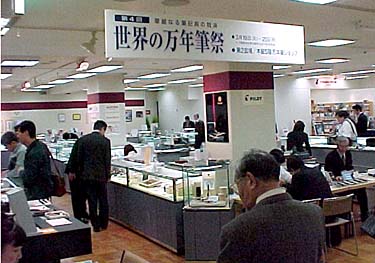 Entrance to the Mitsukoshi Pen Fair
Entrance to the Mitsukoshi Pen Fair
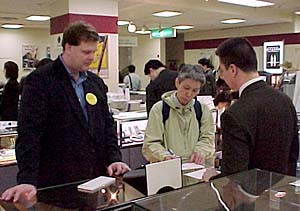 Ron (with yellow snailee badge) and Mikiko
Ron (with yellow snailee badge) and Mikiko
with an Aurora representative |
Not suprising to Pentracers, my mood changed for the better as I met up with Russ Stutler and Mikiko Yamamoto at Mitsukoshi. Particularly when Russ, without hesitation, pulled a Snailee badge from his bag and urged me to wear it. While somewhat self-conscious at first, it was an honor to be asked and so I proudly wore it throughout the Fair. As another benefit, the Snailee badge did get us noticed quite a lot. No, despite our movie-star good looks and the added attraction of the bright-yellow Snailee badge, Russ and I weren't fending off Victoria Secret models. Rather, we were the subject of deep interest and inquiries from the pen company representatives, and the badge was a great conversation starter.
Upon reflection, the Pen Fair that day suggested that the Japanese fountain pen industry is very representative of Japanese culture as I have experienced it. That is, a blending of tradition and respect for the past together with a desire, for some, to be as modern as possible.
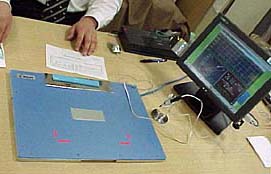 Pilot's handwriting style analyzer
Pilot's handwriting style analyzer |
The most noticeable evidence of a modern approach was at the Pilot booth as you entered the Pen Fair. At the booth was a computerized instrument that the Pilot representative purported to be capable of analyzing one's handwriting, with the goal of advising one on proper nib type for their writing style. No doubt the technology and expertise exists in Japan to measure handwriting features such as, for example, the amount of pressure placed on the nib when writing. Indeed, one walk through the Akihabara section of Tokyo and its blocks of miniaturized, computerized, and digitized whatchamacallits for sale can make one believe that technology can be applied to anything.
 Ron has his handwriting style analyzed
Ron has his handwriting style analyzed |
All of us Pentracers eventually had our handwriting analyzed that day. Skeptical as I am about the results based on a one-time test of just writing our signature, it was great fun comparing amongst one another the pitch and roll that we held the pen at, along with our writing pressure, and finally our alleged nib style. As far as pressure on the nib, for those of you considering lending Russ your vintage pen with the smooth, flexible nib -- forgedaboudit!!
 The results on the monitor. We also received a free printout.
The results on the monitor. We also received a free printout.
However, Pilot also brought their more traditional handwriting analyzer to the Pen Fair, as well as Sailor and Nakaya. For example, the handwriting analyzer that Nakaya brought to the Fair is over 60 years old and unlikely respondent to any machine language. Nakaya uses a device named the "Sadao Watanabe." At this Pen Fair, as well as an earlier one that I had attended with Mikiko, the Watanabe device was in constant use and seemed very efficient and reliable. I understand that the Watanabe device was used by the Platinum Pen Company for over 40 years before being acquired by Nakaya, a record of longevity likely not to be matched by most modern machinery or computers.
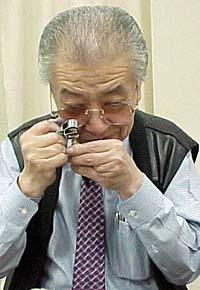 Nakaya's handwriting style analyzer device: The Sadao Watanabe
Nakaya's handwriting style analyzer device: The Sadao Watanabe |
In operation, the Watanabe device employs two eyes operable as scanners that scan a user as s/he is writing with a pen. Images from the scan are converted into signals used by the brain of the Watanabe device. The brain includes a database that is updated based on constant input over many years. As such, the brain is termed a "learning brain."
Also unique to the Watanabe device is its ability to ask verbal questions should any of the input information from the scan be unclear, or should the user desire a nib/feed set-up that is non-standard. What really distinguishes the Watanabe device from the computer handwriting analyzer is that the Watanabe device is operable to perform maintenance on the pen based on the results of the scan and the user input, a feature not present on the newer, computer handwriting analyzer.
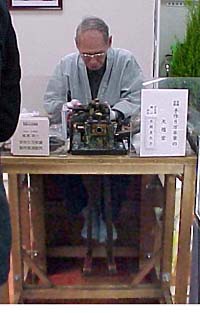 Mr. Uehara on foot-powered lathe Mr. Uehara on foot-powered lathe |
One highlight of the fair was seeing first hand the tools used by the handmade pen makers. In both cases, Mr. Kohsuke Matsubara of Nakaya and Mr. Eiichi Uehara of Ohashi-do utilized old lathes that were powered by their feet. Of course, like good craftsman, they also sharpened their lathe tools by themselves before beginning their work. Norm Abram would be proud. Using his lathe, Mr. Matsubara demonstrated how threads were placed on the barrel of a pen, seemingly making it look easy and proudly offering us his magnifier so that we could examine the results close up. It's really a delight to meet these craftsman in person. They not only are welcoming, but from their smiles and laughter, one can appreciate that they are truly lucky in finding a profession that has made them happy for many decades.
Also on display at the Fair were Japanese Maki-e pens. Maki-e is a Japanese lacquer technique ornamented with use of gold powder. As explained to Mikiko and I at an earlier Pen Fair in March by a Namiki Maki-e artist, Japan was once referred to as "a land of gold" on voyage notes by Marco Polo. It is suggested that these entries were made partly because of the many Maki-e daily goods, such as wooden boxes, in use at that time.
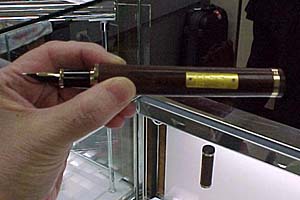 Bamboo pen at the Sailor booth. The gold plate is engraved with the name of the Pen Master who created it, Mr. Nagahara
Bamboo pen at the Sailor booth. The gold plate is engraved with the name of the Pen Master who created it, Mr. Nagahara |
Further, most of the larger, well known fountain pen manufacturers were present at the Fair displaying pens made from materials as diverse as ebonite, bamboo, "precious resin", leather, metals, etc. - some of these pens making me question if one would (or even could) ever use them for writing purposes because of their elaborate jewelry. One pen that we did admire, however, was a Mr. Uehara handmade urushi creation capped with pre-ban ivory.
Finally, besides the opportunity to have your pens worked-on and adjusted by the pen representatives at no cost, the Pen Fair allows one to try out most of the pens on display with the pen representatives happily assisting you. This is very helpful in being able to compare several pens and nib sizes during the same day. Also greatly admired is the cultural aspect of Japanese society where many representatives openly display their pens for one to try, with no expectation (or chance for that matter) that they would be taken.
It was a long, but rewarding day. I am thankful to my new friends Mikiko Yamamoto and Russ Stutler for their help in preparing this report, and especially for the fun day!
|